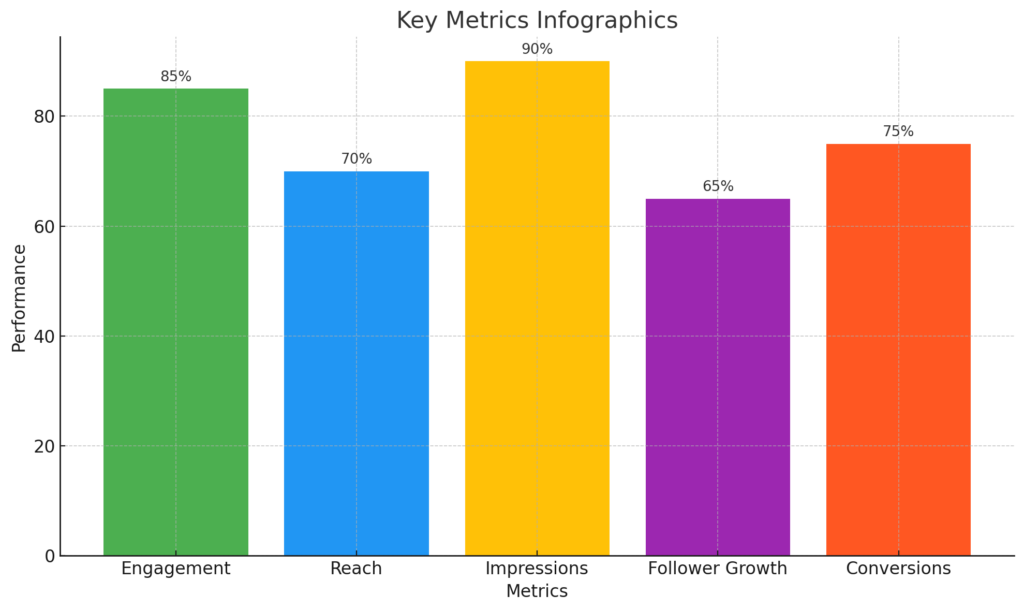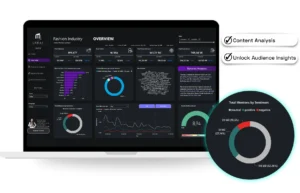In the fast-paced world of digital marketing, performance is paramount. By harnessing the power of social media data, businesses can make data-driven decisions to enhance audience engagement and boost brand success in an ever-evolving digital landscape. Social media platforms offer a wealth of insights that help optimize strategies, create more effective content, and achieve marketing goals.
How Social Media Metrics Transform Marketing Strategies
Social media isn’t just a current trend—it’s much more than that. The concept of a social network that connects people and reflects societal structures has become increasingly complex, especially over the last 14 years.
As markets (and capitalism) have evolved with new dynamics, society has reorganized itself accordingly—and so has the social web that forms the backbone of social media.
This constant evolution is also reshaping how we understand the marketing of products, brands, and ideas. Marketing has undeniably changed—and continues to change—before our eyes.
The growing focus on social intelligence and social insights in marketing reflects the ongoing shift in communication. Communication is not only the process of transmitting a message to someone in a specific context through some medium, but also information with monetary value that can enhance brand awareness investments.
These changes have transformed the way brands approach marketing, with a heightened focus on communication performance and data-driven strategies.
The goal of this article is to explore these changes in marketing by examining how social media performance data provides a holistic view of effective communication, helping you turn your audience into customers.


Understanding Social Media Performance Data
In today’s digital landscape, social media has become an essential tool for businesses to connect with their audience and promote their content. With millions of users actively engaging on social networks, organizations rely heavily on these platforms to build brand awareness, increase viewership, and retain subscribers. However, the real power of social media lies not only in its reach, but also in the data it generates.
Tracking social media performance data allows companies to gain valuable insights into their audience’s behaviors and engagement patterns. By analyzing key metrics such as engagement rates, reach, and follower growth, organizations can refine their marketing strategies, create content that resonates with their target audience, and ultimately drive more conversions.
It is possible to use social media performance data to stay competitive in a crowded market. From this information, brands can build effective strategies and gain actionable business insights.
What is Social Media Performance Data?
Social media performance data refers to the collection and analysis of metrics that measure how well content performs on social media platforms. This data provides a snapshot of how audiences engage with a brand, helping companies understand which strategies are driving results and which need improvement.
This data is critical for determining which content is resonating with users, which campaigns attract new subscribers, and how social media is contributing to overall business growth.
In digital marketing, social media performance data is key to refining strategies and maximizing ROI. By continuously tracking and analyzing this data, organizations can make informed decisions, optimize campaigns, and stay ahead in a competitive market.
Key Metrics Used to Measure Social Media Success
- Engagement: Measures how actively users interact with your content through likes, comments, shares, and clicks. High engagement indicates strong audience interest and can amplify the reach of content through organic sharing.
- Reach: Indicates how many unique users have seen your content. Streaming platforms use this metric to assess how effectively they’re expanding their audience and gaining visibility.
- Impressions: Counts the total number of times content has been displayed, regardless of clicks. While similar to reach, impressions help gauge how frequently content appears in front of users.
- Follower Growth: Tracks the increase in followers over time. Steady growth signals rising brand interest, while sudden spikes often indicate successful campaigns or viral content.
- Conversions: Refers to actions taken as a result of social media engagement, such as signing up for a free trial, subscribing to a service, or making a purchase. Conversion data directly ties social media efforts to business outcomes.


By regularly analyzing these metrics, companies can identify trends, evaluate the success of marketing efforts, and tailor future content to better connect with their audience.
How Social Media Algorithms Work: What Metrics Matter Most?
Social media algorithms are designed to determine which content users see in their feeds, aiming to show the most relevant and engaging posts first. Each platform has its own unique algorithm, but they all share a common goal: to enhance user experience by prioritizing content that users are most likely to interact with.
This changes the way content producers brainstorm and build their posts ideas, as they will produce their posts with an eye toward meeting algorithmic priorities to get their content distribu ted more effectively.
While algorithms constantly evolve, they generally reward content based on specific metrics that indicate its relevance, engagement potential, and user satisfaction.


How can social media metrics help brands?
Social media metrics like Engagement, Reach, and Post Interactions provide brands with valuable insights that can drive strategic decisions and optimize their content and marketing efforts:
Engagement (likes, comments, shares, views):
- Content Resonance: Measures how compelling and relatable the content is to the audience. High engagement rates often indicate content that effectively connects with viewers, suggesting themes or formats that could be expanded.
- Audience Relationship: Higher engagement signifies strong relationships with the audience, essential for building brand loyalty and a dedicated viewer base.
Reach (the number of unique users who see the posts):
- Brand Awareness: Helps in understanding how far the content is traveling beyond the existing followers. This is crucial for acquiring new subscribers and expanding the market presence.
- Target Market Penetration: Analyzing reach can help identify if the brand is effectively reaching its target demographic or if adjustments in marketing strategies are needed.
Post Interactions (total interactions including all forms of engagement):
- Content Strategy Optimization: By analyzing which types of posts generate the most interactions, brands can tailor their content strategies to produce more of what works best, potentially increasing viewer satisfaction and retention.
- Algorithm Favorability: Platforms like Facebook and Instagram use interactions as a key metric to decide what content gets more visibility. Higher interactions can lead to better organic reach.
How to Leverage Social Media Data for Brand Success
Analyzing social media data not only helps brands measure the success of their campaigns but also offers actionable insights that can shape their overall business strategy. Here’s how brands can effectively leverage social media performance data to achieve success:
1. Audience Segmentation
Social media metrics allow brands to divide their audience into specific segments based on behavior, interests, and engagement patterns. This segmentation guides brands in creating highly targeted campaigns that resonate with different audience groups, increasing conversion chances
2. Content Personalization
With deep insights into what types of content perform best, brands can personalize their social media posts to cater to their audience’s preferences. Personalized content increases engagement, builds trust, and improves customer relationships.
3. Competitive Benchmarking
Social media performance data also enables brands to compare their performance with competitors. By assessing competitors’ metrics like engagement, reach, and follower growth, brands can identify gaps and opportunities to differentiate their strategy and stay ahead of the competition.
4. Real-Time Feedback and Adaptation
Social media provides real-time feedback from the audience. Brands can quickly assess whether a campaign is resonating or falling flat by looking at real-time data, allowing for quick adaptations to content and strategy.
Challenges and Considerations in Using Social Media Metrics
While social media data offers immense value, it also presents certain challenges that brands must navigate carefully.
1. Data Overload
With the vast amount of metrics available, it can be overwhelming to sift through all the data. Brands must focus on the key metrics that align with their business objectives and avoid getting lost in vanity metrics that don’t provide meaningful insights.
2. Constant Algorithm Changes
Social media platforms frequently update their algorithms, which can impact how content is ranked and displayed. Keeping up with these changes and adapting strategies accordingly is crucial to maintaining a strong social media presence.
3. Privacy Concerns
As social media platforms handle vast amounts of personal data, concerns about user privacy and data protection have grown. Brands must ensure they are using data ethically and comply with regulations like GDPR to avoid damaging their reputation.
Loxias Performance Central Business Insights (CBI) to overcome this challenges
Loxias Performance Central Business Insights is a customized and dedicated real-time panel that brings your social media key metrics to the forefront, enabling data-driven business and marketing decision-making.
With CBI you can dive into an in-depth analysis of your brand’s social media and content performance, gaining critical insights on how to adapt to algorithm changes—all while ensuring privacy compliance, as Loxias operates in full accordance with GDPR..
More than that, our platform allows you to:
- Understand Audience Behavior: By analyzing how your audience interacts with your content, Loxias provides valuable insights that help you personalize your messaging and connect more effectively with your target audience.
- Strategic Algorithm Management: Loxias empowers you to stay ahead of social media algorithm changes, ensuring your content distribution strategies are always aligned with platform priorities, increasing visibility and engagement.
- Competitor Analysis and Forecasting: With a deep dive into competitors’ social media strategies, our panel helps you understand where they’re headed, allowing you to anticipate their next steps and maintain a competitive edge.
- Optimize Content for Maximum Engagement: Through its real-time analysis, Loxias enables you to continually refine your content strategy by identifying what works and what doesn’t, ensuring your social media efforts generate the highest levels of engagement, reach, and conversions.
- Data-Driven Marketing Strategies: By bringing together all your social media metrics in one place, Loxias offers a comprehensive view of your performance. This enables you to create more effective, data-backed marketing strategies that can drive brand awareness, audience growth, and business success.
Our panel will also help you forecast trends, identify untapped opportunities, and adjust your campaigns in real-time to ensure optimal results.
The Future of Social Media and Data-Driven Marketing
Social media platforms will continue to evolve, and as they do, the importance of social media performance data will only grow. Brands that actively track and analyze their social media metrics will be in a better position to connect with their audience, optimize their content, and stay competitive in a crowded digital landscape.
By leveraging data-driven insights, brands can enhance their marketing strategies, create more impactful campaigns, and ultimately, turn social media followers into loyal customers. The future of marketing is undeniably rooted in data, and social media offers an endless stream of valuable information for those willing to dive in and analyze.
Enjoying our content? Sign up for our newsletter and be the first to receive our latest articles. Stay informed on data analytics insights, business intelligence trends, marketing strategies, and the latest advancements in artificial intelligence.


